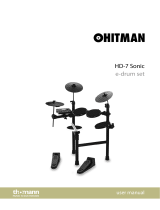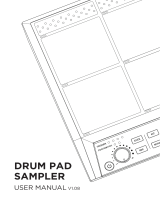
6
IMPORTANT NOTES
Power Supply
301
• Do not connect this unit to same electrical
outlet that is being used by an electrical
appliance that is controlled by an
inverter or a motor (such as a refrigerator,
washing machine, microwave oven, or
air conditioner). Depending on the way
in which the electrical appliance is used,
power supply noise may cause this unit
to malfunction or may produce audible
noise. If it is not practical to use a separate
electrical outlet, connect a power supply
noise lter between this unit and the
electrical outlet.
307
• To prevent malfunction and equipment
failure, always make sure to turn o the
power on all your equipment before you
make any connections.
308
• Although the LCD and LEDs are switched
o when the unit is turned o, this
does not mean that the unit has been
completely disconnected from the source
of power. If you need to turn o the power
completely, rst turn o the unit’s switch,
then unplug the power cord from the
power outlet. For this reason, the outlet
into which you choose to connect the
power cord’s plug should be one that is
within easy reach and readily accessible.
309
• With the factory settings, the TD-30 will
automatically be switched o 4 hours
after you stop playing or operating the
unit. If you don’t want the unit to turn o
automatically, change the “AUTO OFF”
setting to “OFF” as described on p. 124.
Placement
351
• Using the unit near power ampliers (or
other equipment containing large power
transformers) may induce hum. To alleviate
the problem, change the orientation of
this unit; or move it farther away from the
source of interference.
352a
• This device may interfere with radio and
television reception. Do not use this device
in the vicinity of such receivers.
352b
• Noise may be produced if wireless
communications devices, such as cell
phones, are operated in the vicinity of
this unit. Such noise could occur when
receiving or initiating a call, or while
conversing. Should you experience such
problems, you should relocate such
wireless devices so they are at a greater
distance from this unit, or switch them o.
354a
• Do not expose the unit to direct sunlight,
place it near devices that radiate heat,
leave it inside an enclosed vehicle, or
otherwise subject it to temperature
extremes. Excessive heat can deform or
discolor the unit.
355b
• When moved from one location to
another where the temperature and/or
humidity is very dierent, water droplets
(condensation) may form inside the unit.
Damage or malfunction may result if you
attempt to use the unit in this condition.
Therefore, before using the unit, you must
allow it to stand for several hours, until the
condensation has completely evaporated.
360
• Depending on the material and
temperature of the surface on which you
place the unit, its rubber feet may discolor
or mar the surface.
You can place a piece of felt or cloth
under the rubber feet to prevent this from
happening. If you do so, please make
sure that the unit will not slip or move
accidentally.
361
• Do not put anything that contains
water on this unit. Also, avoid the use of
insecticides, perfumes, alcohol, nail polish,
spray cans, etc., near the unit. Swiftly wipe
away any liquid that spills on the unit using
a dry, soft cloth.
Maintenance
401a
• For everyday cleaning wipe the unit with a
soft, dry cloth or one that has been slightly
dampened with water. To remove stubborn
dirt, use a cloth impregnated with a mild,
non-abrasive detergent. Afterwards, be
sure to wipe the unit thoroughly with a
soft, dry cloth.
402
• Never use benzine, thinners, alcohol
or solvents of any kind, to avoid the
possibility of discoloration and/or
deformation.
Repairs and Data
452
• Please be aware that all data contained
in the unit’s memory may be lost when
the unit is sent for repairs. Important data
should always be backed up USB ash
drives, or written down on paper (when
possible). During repairs, due care is
taken to avoid the loss of data. However,
in certain cases (such as when circuitry
related to memory itself is out of order),
we regret that it may not be possible to
restore the data, and Roland assumes no
liability concerning such loss of data.
Additional Precautions
551
• Please be aware that the contents of
memory can be irretrievably lost as a
result of a malfunction, or the improper
operation of the unit. To protect yourself
against the risk of loosing important data,
we recommend that you periodically save
a backup copy of important data you have
stored in the unit’s memory on USB ash
drives.
552
• Unfortunately, it may be impossible
to restore the contents of data that
was stored in the unit’s memory or
USB ash drives once it has been lost.
Roland Corporation assumes no liability
concerning such loss of data.
553
• Use a reasonable amount of care when
using the unit’s buttons, sliders, or other
controls; and when using its jacks and
connectors. Rough handling can lead to
malfunctions.
554
• Never strike or apply strong pressure to
the display.
556
• When disconnecting all cables, grasp the
connector itself—never pull on the cable.
This way you will avoid causing shorts, or
damage to the cable’s internal elements.
557
• A small amount of heat will radiate from
the unit during normal operation.
558a
• To avoid disturbing others nearby, try
to keep the unit’s volume at reasonable
levels. You may prefer to use headphones,
so you do not need to be concerned about
those around you.
558d
• This instrument is designed to minimize
the extraneous sounds produced when it’s
played. However, since sound vibrations
can be transmitted through oors and
walls to a greater degree than expected,
take care not to allow these sounds to
become a nuisance others nearby.
559a
• When you need to transport the unit,
package it in the box (including padding)
that it came in, if possible. Otherwise, you
will need to use equivalent packaging
materials.
562
• Some connection cables contain resistors.
Do not use cables that incorporate
resistors for connecting to this unit. The
use of such cables can cause the sound
level to be extremely low, or impossible
to hear. For information on cable
specications, contact the manufacturer
of the cable.





















